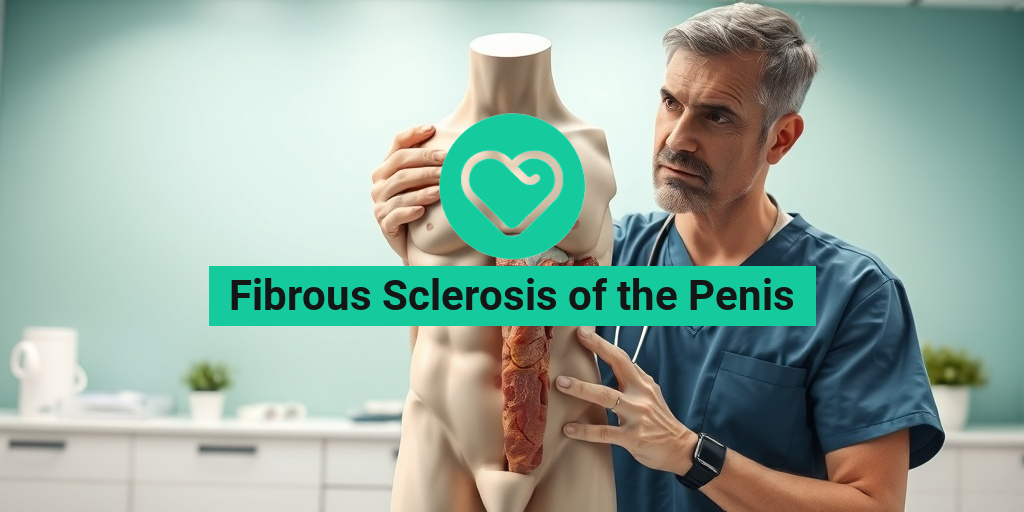What Is Fibrous Sclerosis of the Penis?
Fibrous Sclerosis of the Penis, often referred to as Peyronie’s disease, is a condition characterized by the formation of fibrous scar tissue inside the penis. This condition can lead to significant changes in the shape and size of the penis, often resulting in painful erections and difficulties during sexual intercourse. Understanding this condition is crucial for those affected, as it can impact both physical health and emotional well-being.
Understanding the Causes
The exact cause of Fibrous Sclerosis of the Penis remains unclear, but several factors may contribute to its development:
- Trauma or Injury: Physical trauma to the penis, whether from sexual activity or injury, can lead to scar tissue formation.
- Genetic Factors: Some individuals may have a genetic predisposition to developing this condition.
- Age: The risk of developing fibrous sclerosis increases with age, particularly in men over 40.
- Connective Tissue Disorders: Conditions that affect connective tissue may also play a role in the development of this disease.
How Common Is It?
Fibrous Sclerosis of the Penis is more common than many might think. Studies suggest that it affects approximately 1 in 100 men, with varying degrees of severity. Despite its prevalence, many men may feel embarrassed to discuss their symptoms, leading to underdiagnosis and undertreatment.
Symptoms of Fibrous Sclerosis
The symptoms of Fibrous Sclerosis of the Penis can vary widely among individuals, but there are several common signs to be aware of:
Physical Symptoms
- Painful Erections: Many men experience discomfort or pain during erections, which can significantly affect sexual activity.
- Curvature of the Penis: One of the hallmark symptoms is a noticeable bend or curve in the penis, which may occur during erections.
- Shortening of the Penis: Some men report a decrease in penile length, which can be distressing.
- Palpable Plaques: The formation of hard lumps or plaques can often be felt under the skin of the penis.
Emotional and Psychological Impact
Beyond the physical symptoms, Fibrous Sclerosis of the Penis can have a profound emotional and psychological impact. Many men experience:
- Reduced Self-Esteem: Changes in penile appearance and function can lead to feelings of inadequacy.
- Anxiety and Depression: The stress of dealing with a chronic condition can contribute to mental health issues.
- Relationship Strain: Difficulties in sexual performance can affect intimate relationships, leading to further emotional distress.
When to Seek Help
If you notice any of the symptoms mentioned above, it is essential to consult a healthcare professional. Early diagnosis and intervention can help manage the condition effectively and improve quality of life. Don’t hesitate to reach out to a urologist or a specialist in men’s health for guidance.
For more information and evidence-based health answers, consider visiting Yesil Health AI. They provide valuable resources that can help you understand your health better.
Conclusion
Fibrous Sclerosis of the Penis is a condition that affects many men, yet it often goes undiscussed. Understanding the symptoms and seeking timely medical advice can make a significant difference in managing this condition. Remember, you are not alone, and help is available! 🌟

Causes and Risk Factors
Fibrous Sclerosis of the Penis, also known as Peyronie’s disease, is a condition characterized by the development of fibrous scar tissue inside the penis, leading to curved, painful erections. Understanding the causes and risk factors associated with this condition is crucial for prevention and early intervention.
What Causes Fibrous Sclerosis of the Penis?
The exact cause of fibrous sclerosis remains largely unknown, but several factors may contribute to its development:
- Trauma or Injury: Physical trauma to the penis, whether from sexual activity, sports injuries, or accidents, can lead to the formation of scar tissue.
- Genetic Factors: A family history of Peyronie’s disease may increase the likelihood of developing fibrous sclerosis, suggesting a genetic predisposition.
- Connective Tissue Disorders: Conditions that affect connective tissues, such as Dupuytren’s contracture, may also be linked to fibrous sclerosis.
- Age: The risk of developing this condition increases with age, particularly in men over 40.
- Medical Conditions: Certain health issues, such as diabetes, high blood pressure, and hyperlipidemia, can increase the risk of developing fibrous sclerosis.
Identifying Risk Factors
While anyone can develop fibrous sclerosis, certain risk factors may heighten the chances:
- Age: As mentioned, older men are at a higher risk.
- Smoking: Tobacco use can impair blood flow and contribute to the development of scar tissue.
- Obesity: Excess weight can lead to various health issues, including those that may increase the risk of Peyronie’s disease.
- Previous Penile Surgery: Men who have undergone surgery on the penis may be at an increased risk of developing fibrous sclerosis.
Understanding these causes and risk factors can help in recognizing the early signs of fibrous sclerosis and seeking timely medical advice. If you notice any changes in your penile structure or experience pain during erections, it’s essential to consult a healthcare professional. 🩺
Diagnosis of Fibrous Sclerosis
Diagnosing fibrous sclerosis of the penis involves a combination of medical history, physical examinations, and sometimes imaging tests. Early diagnosis is vital for effective management and treatment of the condition.
Medical History and Symptoms
The first step in diagnosis typically involves a thorough medical history. Your healthcare provider will ask about:
- Symptoms: Discuss any pain, curvature, or changes in the shape of your penis during erections.
- Duration: How long have you been experiencing these symptoms?
- Previous Injuries: Any history of trauma to the genital area?
Being open and honest about your symptoms can significantly aid in the diagnostic process. 🗣️
Physical Examination
During a physical examination, the doctor will:
- Inspect the Penis: Look for any palpable plaques or areas of hard tissue.
- Assess Curvature: Evaluate the degree of curvature during an erection, which may be induced through a penile injection.
This examination helps determine the severity of the condition and guides treatment options.
Imaging Tests
In some cases, imaging tests may be necessary to confirm the diagnosis. These can include:
- Ultrasound: This non-invasive test uses sound waves to create images of the penis, helping to identify the location and extent of scar tissue.
- X-rays or MRI: These may be used in specific cases to provide a more detailed view of the penile structure.
Early diagnosis of fibrous sclerosis of the penis is crucial for effective treatment and management. If you suspect you may have this condition, don’t hesitate to reach out to a healthcare professional for guidance. Remember, addressing concerns early can lead to better outcomes! 🌟

Treatment Options Available
Fibrous Sclerosis of the Penis, also known as Peyronie’s disease, can be a challenging condition for many men. It is characterized by the development of fibrous scar tissue inside the penis, leading to curved, painful erections. Fortunately, there are several treatment options available that can help manage the symptoms and improve quality of life.
Medications
One of the first lines of treatment for Fibrous Sclerosis of the Penis often involves medications. These can include:
- PDE5 inhibitors: Drugs like sildenafil (Viagra) and tadalafil (Cialis) can help improve blood flow and may alleviate some symptoms.
- Intralesional injections: Medications such as collagenase clostridium histolyticum (Xiaflex) can be injected directly into the plaque to help break it down.
- Oral medications: Some studies suggest that oral medications like pentoxifylline may help reduce plaque size and improve curvature.
Physical Therapy
Physical therapy techniques, including penile traction therapy, can be beneficial for some men. This method involves using a device that gently stretches the penis, which may help reduce curvature and improve overall function. Regular sessions can lead to significant improvements over time.
Surgical Options
For men with severe curvature or those who experience significant pain, surgical intervention may be necessary. Surgical options include:
- Plication surgery: This procedure involves shortening the side of the penis opposite the plaque to straighten it.
- Grafting: In cases where there is significant loss of penile length, grafting may be performed to restore function and appearance.
- Penile prosthesis: For men with erectile dysfunction due to Peyronie’s disease, a penile prosthesis may be an option to restore sexual function.
Consultation with a Specialist
It’s crucial to consult with a urologist who specializes in male sexual health to determine the best treatment plan tailored to individual needs. They can provide guidance on the most effective options based on the severity of the condition and personal health history.
Home Remedies and Care
In addition to medical treatments, many men seek home remedies and self-care strategies to manage Fibrous Sclerosis of the Penis. While these methods may not replace professional treatment, they can complement medical interventions and promote overall penile health.
Warm Compresses
Applying warm compresses to the affected area can help reduce discomfort and improve blood flow. This simple method can be done at home and may provide temporary relief from pain associated with the condition. Just ensure the compress is warm, not hot, to avoid burns. 🔥
Diet and Nutrition
Maintaining a healthy diet can play a role in managing symptoms. Foods rich in antioxidants, such as fruits and vegetables, can help reduce inflammation. Consider incorporating:
- Berries: Packed with antioxidants that combat oxidative stress.
- Leafy greens: High in vitamins and minerals that support overall health.
- Omega-3 fatty acids: Found in fish like salmon, these can help reduce inflammation.
Regular Exercise
Engaging in regular physical activity can improve blood circulation and overall health. Activities such as walking, swimming, or cycling can be beneficial. Exercise not only helps maintain a healthy weight but also reduces stress, which can exacerbate symptoms. 🏋️♂️
Stress Management
Stress can have a significant impact on sexual health. Techniques such as meditation, yoga, or deep-breathing exercises can help manage stress levels. Finding time for relaxation and self-care can improve both mental and physical well-being.
Open Communication
Discussing concerns with a partner can alleviate anxiety and improve intimacy. Open communication about the condition can foster understanding and support, making it easier to navigate the challenges associated with Fibrous Sclerosis of the Penis.
While home remedies and care strategies can provide relief, they should be used in conjunction with professional medical advice for the best outcomes. Always consult with a healthcare provider before starting any new treatment or remedy. 🩺

Potential Complications
Fibrous Sclerosis of the Penis, also known as Peyronie’s disease, can lead to several complications that may affect both physical health and emotional well-being. Understanding these potential complications is crucial for anyone diagnosed with this condition.
1. Erectile Dysfunction
One of the most common complications associated with Fibrous Sclerosis of the Penis is erectile dysfunction (ED). The fibrous tissue that develops can interfere with the normal function of the penis, making it difficult to achieve or maintain an erection. This can lead to frustration and anxiety, further exacerbating the issue.
2. Pain During Intercourse
Many individuals with fibrous sclerosis experience pain during erections or sexual intercourse. This discomfort can stem from the curvature of the penis caused by the fibrous tissue, which may lead to a painful experience for both partners. Addressing this issue is essential for maintaining a healthy sexual relationship.
3. Psychological Impact
The emotional toll of living with Fibrous Sclerosis of the Penis can be significant. Men may experience feelings of embarrassment, anxiety, or depression due to changes in their sexual function and body image. Seeking support from mental health professionals or support groups can be beneficial in managing these feelings.
4. Changes in Penile Appearance
As the condition progresses, some men may notice changes in the appearance of their penis, including curvature or shortening. These physical changes can affect self-esteem and confidence, leading to further emotional distress.
5. Infertility Concerns
While Fibrous Sclerosis of the Penis does not directly cause infertility, the complications associated with the condition can impact a man’s ability to conceive. Issues such as erectile dysfunction and painful intercourse can hinder the chances of successful conception, leading to concerns for couples trying to start a family.
Living with Fibrous Sclerosis
Living with Fibrous Sclerosis of the Penis can be challenging, but there are ways to manage the condition effectively. Here are some strategies that can help improve quality of life:
1. Open Communication with Partners
Having open and honest conversations with your partner about the condition can foster understanding and support. Discussing any concerns or discomfort can help both partners navigate the challenges together, enhancing intimacy and emotional connection. 💬
2. Seeking Medical Advice
Regular consultations with a healthcare provider are essential for managing Fibrous Sclerosis of the Penis. Treatment options may include medications, injections, or even surgical interventions, depending on the severity of the condition. Your doctor can help tailor a treatment plan that suits your needs.
3. Exploring Treatment Options
There are various treatment options available for Fibrous Sclerosis of the Penis, including:
- Medications: Oral medications or injections may help reduce pain and curvature.
- Vacuum Devices: These can assist in achieving and maintaining an erection.
- Surgery: In severe cases, surgical options may be considered to correct curvature or restore function.
4. Lifestyle Modifications
Making certain lifestyle changes can also help manage symptoms. Maintaining a healthy weight, exercising regularly, and avoiding smoking can improve overall health and potentially alleviate some symptoms associated with Fibrous Sclerosis of the Penis. 🏋️♂️
5. Emotional Support
Joining support groups or seeking therapy can provide emotional relief. Connecting with others who understand your experiences can be incredibly beneficial. Sharing stories and coping strategies can help you feel less isolated and more empowered. 🤝
In conclusion, while Fibrous Sclerosis of the Penis presents various challenges, understanding potential complications and adopting effective management strategies can significantly improve quality of life. Remember, you are not alone in this journey, and support is available.

Frequently Asked Questions about Fibrous Sclerosis of the Penis
What is Fibrous Sclerosis of the Penis?
Fibrous Sclerosis of the Penis is a condition characterized by the formation of fibrous tissue within the penile shaft. This can lead to various symptoms, including pain, curvature, and difficulty during erections.
What are the symptoms of Fibrous Sclerosis of the Penis?
- Painful erections
- Curvature of the penis
- Difficulty achieving or maintaining an erection
- Changes in penile size or shape
What causes Fibrous Sclerosis of the Penis?
The exact cause of Fibrous Sclerosis of the Penis is not fully understood. However, it may be associated with trauma, genetic factors, or other underlying health conditions. In some cases, it can develop without any identifiable cause.
How is Fibrous Sclerosis of the Penis diagnosed?
A healthcare provider typically diagnoses this condition through a physical examination and a review of the patient’s medical history. Imaging tests, such as ultrasound, may also be used to assess the extent of fibrous tissue formation.
What are the treatment options for Fibrous Sclerosis of the Penis?
- Medications: Anti-inflammatory drugs or medications to improve blood flow may be prescribed.
- Injections: Corticosteroid injections can help reduce inflammation.
- Surgery: In severe cases, surgical intervention may be necessary to correct curvature or remove fibrous tissue.
Can Fibrous Sclerosis of the Penis affect sexual health?
Yes, this condition can significantly impact sexual health. The pain and curvature associated with Fibrous Sclerosis of the Penis can lead to difficulties in sexual performance and may affect emotional well-being.
Is Fibrous Sclerosis of the Penis a common condition?
While not extremely common, Fibrous Sclerosis of the Penis does occur in a significant number of men, particularly those in middle age. Awareness and early diagnosis can help manage symptoms effectively.
When should I see a doctor?
If you experience symptoms such as persistent pain, curvature, or changes in your erections, it is important to consult a healthcare provider. Early intervention can lead to better outcomes.
Are there any lifestyle changes that can help manage Fibrous Sclerosis of the Penis?
Maintaining a healthy lifestyle can support overall penile health. This includes:
Can Fibrous Sclerosis of the Penis be prevented?
While there is no guaranteed way to prevent this condition, minimizing trauma to the penis and maintaining overall health may reduce the risk of developing Fibrous Sclerosis.
Where can I find more information about Fibrous Sclerosis of the Penis?
For more information, consider consulting a healthcare professional or visiting reputable medical websites that specialize in men’s health.




